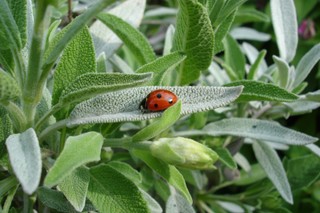Grow sage indoors: Supplies, methods, and tips

Sage is known for the center stage role it plays at Thanksgiving and Christmas dinners – flavoring poultry dishes and stuffing. The smell alone can invoke memories of holidays spent with family, gathered in the kitchen or around the table. Its strong aroma and overall hardiness make it worth adding a single plant to your indoor collection!
Basic sage info
Garden sage (also known by its botanical name, Salvia officinalis) is the type most commonly used for culinary purposes. It has silvery-green leaves and violet flowers. But there are many different garden sage varieties to choose from.
- Dwarf varieties grow to only about 12-inches tall and bloom in purple flowers.
- Purple garden sage has purple foliage when young and doesn’t bloom as often as other types.
- Golden sage has gold and green variegated leaves and is a creeping variety.
- Tricolor looks similar to purple sage but the variegated leaves include white.
- Berggarten sage is very similar to garden sage but doesn’t bloom.
Plants are typically used to flavor poultry and bean dishes, as well as stuffings. The flavor of sage leaves is quite intense, so a single plant will provide you with everything you need year-round.
Supplies needed for growing sage indoors
With a few basic supplies, it’s easy to start growing sage plants.
Containers: A clay pot (either glazed or unglazed) is the best choice in this situation. Clay allows better air movement through the walls of the container, and in turn, the growing media will dry out more quickly. Salvia plants do not like to sit in wet soil.
Growing Media: Commercial potting mixes and coconut coir are both excellent substrates for growing herbs in containers. Both media are lightweight with excellent moisture retention yet allow excess water to drain freely.
Plants: Sage can be started from seeds for propagated through stem cuttings or a technique known as “layering”. Many gardeners opt to propagate new plants instead of sowing seeds because plants reach maturity quicker.

Planting instructions
Growing sage from either seeds or stem cuttings are both simple methods with the big difference being in cost: seeds have to be purchased, while propagation methods are free if you have access to healthy plants.
Starting sage from seeds follows basic sowing methods:
- Fill the container(s) with the pre-moistened growing media of your choice.
- Sprinkle a small number of sage seeds across the top of the substrate and cover with a thin layer of media.
- Place container(s) in an area where the ambient temperature is at least 70℉.
- Keep the soil moist but not saturated.
- Thin plants when they reach a couple of inches tall. Keep the single, best-looking plant for an 8-inch container.
To start sage plants from stem cuttings follow these directions:
- Fill the container(s) with pre-moistened growing media of your choice.
- Take a 4-inch stem cutting right below a node and remove all of the leaves from the bottom 2 inches of the stem.
- Place the cut end of the stem in rooting hormone.
- Carefully plant cuttings in containers.
Propagate via layering using this protocol:
- Take a long stem from an existing plant and bend it down towards the soil/potting mix, making sure you don’t snap it off the plant.
- Secure the stem to the growing media using wire or small metal stakes leaving the top 3 to 4-inches of the stem free.
- Within a month new roots should start to form from the nodes in contact with the soil.
- Carefully cut away the newly rooted stem from the main plant and transplant it into a container.
Growing tips
Sage plants are incredibly drought-tolerant, hardy perennial plants. They are fairly low maintenance when grown as indoor plants.
- Water containers when the soil is dry to the touch. Sage is native to tropical regions of the Mediterranean but does not like soggy roots.
- Avoid getting water on the foliage when watering the plants - water the soil directly if possible - and maintain good air circulation to lower the incidence of powdery mildew.
- Keep plants on a windowsill of a sunny window so plants are exposed to at least 6 to 8-hours of sunlight daily. Sage is adapted to lots of sunlight outside, making it difficult to give it enough light indoors. If necessary, supplement plants with light via fluorescent or high-intensity discharge (HID) growing lights; simple lights can be purchased online or a local garden center.
- Monitor sage plants closely for whiteflies, aphids, and spider mites, especially if you introduce new houseplants to your indoor garden.
- Periodically prune off branch tips to encourage your plant to grow outward instead of upward for a fuller shape.
 Drying sage is a great way to preserve your harvest for later!
Drying sage is a great way to preserve your harvest for later!
Harvesting sage
The first year you are growing your plant(s), harvest the foliage lightly to allow the plant to reach its full size. After they are established they respond well to frequent harvesting; regularly removing foliage from your plants will trigger new growth, encouraging full, bushy plants.
Harvesting sage is straight-forward as with many other indoor-grown herbs.
- Harvest sage in the morning if possible.
- Using clean, sharp scissors or even your fingernails, snip or cut off stems right above the node where a pair of leaves originates. Do not leave a stub of the stem on the plant.
- If plants are overgrown, you can do a more severe harvest. Starting from the top of the plant begin harvesting stems, making sure to remove no more than ½ of the plant at any given time.

The enthusiast's guide to herbs
We’re proud to present our new e-book, The Enthusiast’s Guide to Herbs! Learn everything you need to know about growing and caring for herbs indoors, including in-depth info cards for the 35 most commonly grown herbs.
Click the link below to find out more!
Various methods of storing sage
After harvesting, sage leaves can be kept in the fridge, frozen, dried, or preserved in oil.
Sage leaves will keep in the fridge for up to a week.
- Remove leaves from the stems and wrap them in a damp paper towel. Place in a resealable plastic bag and store in the refrigerator.
Frozen sage is used in recipes the same way as fresh, although freezing it causes it to shrink slightly so a smaller amount should be added to a recipe.
- Remove whole leaves from the stems, and blanch for two seconds, immediately placing leaves in an ice bath afterward. Dry completely and store in an air-tight container or freezer bag, separating layers with wax paper.
Drying sage can either be done in a food dehydrator, or by air-drying. Once dried, lightly crush the leaves and store in an air-tight container for use.
- To air dry, bind a clump of 6-inch long stems together. Hang upside down in a dark space where the temperature is warm and the humidity is low.
- To dry it in a food dehydrator, place washed leaves in a single layer on the food dehydrator trays. Dry at the recommended temperature until leaves are crispy.
Preserving in oil is a great option for adding a small touch of sage flavor to dishes without overpowering other flavors.
- Place sage leaves in a small jar or similar container. Cover them with olive oil and use the oil or leaves within three weeks.
Conclusion
Growing a single sage plant will add a highly aromatic, hardy herb to your indoor herb gardening providing you with year-round foliage to flavor your recipes. Plants prefer lots of sun and like their roots to be able to dry out between waterings. Garden sage is commonly grown type but there are different varieties to choose from to fit your wants and needs.

Join our email club—get printable info cards free!
Sign up to receive our newsletter and get access to 10 printable plant info cards from our e-book for free. Also receive:
- $4 discount code for our Guide to Herbs e-book
- Semi-weekly plant inspiration & bite-size tips and tricks
